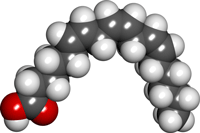GLA is short forgamma-linolenic acid and is a polyunsaturated omega-6 fatty acid – one of the “healthy” fatty acids.
GLA has long been used as a dietary supplement and even as a natural medicine for conditions such as arthritis and eczema, but also a number of other diseases – even though there is no scientific evidence for these properties.
This article will give you a clear overview of what GLA is, where it is found and what effect it has on humans. The fatty acid EPA is also briefly mentioned at the end of the article.
In this article:

What is GLA?
GLA (gamma linolenic acid) is a fatty acid that is necessary for maintaining good health. This is mainly because GLA is a:
- Essential fatty acid: GLA is an essential fatty acid – i.e. a fatty acid that the body cannot produce itself and therefore needs to be supplied externally via diet or supplements
- Omega-6 fatty acid: There are both healthy and unhealthy omega-6 fatty acids – GLA belongs to the healthy (polyunsaturated) omega-6 fatty acids
- Rare fatty acid: GLA is found in very low concentrations in many foods. Natural sources with high concentrations of GLA are few and far between. The most common include certain essential oils (see table below) and spirulina (a blue-green algae)
In summary, GLA is – from a dietary point of view – a very important fatty acid. This has led doctors and researchers to initiate numerous studies on the effects of GLA on various diseases such as eczema, osteoarthritis, rheumatoid arthritis and others. However, the results of these studies have been mixed and there is still no evidence that GLA can be used to treat disease.
The effect of GLA on humans
There is still much disagreement about the specific impact GLA has on the human body and its role in disease, health, etc. GLA is undoubtedly healthy for the body, but some proponents – and especially companies selling GLA-containing products – tend to portray GLA as a dietary supplement with a superior effect on our health, for which there is no scientific evidence.
In addition, it is often claimed that GLA can cure various diseases and disorders, although this has never been proven in controlled scientific studies. Some of the diseases and symptoms that supporters try to cure or alleviate using GLA are:
- Autoimmune diseases
- Rheumatic diseases
- Cancer diseases
- PMS (pre-menstrual syndrome)
It should be emphasized that there is no evidence that GLA can alleviate the above conditions.
Eczema
Atopic eczema (also known as childhood eczema, asthma eczema or atopic dermatitis) is one of the few areas where GLA has some medical recognition. In the UK, GLA was previously approved for the treatment of atopic eczema, but was withdrawn due to a lack of evidence of the oil's effect on eczema.
GLA in oils
The following oils are high in GLA:
| Oil type | Typical GLA content |
| Castor oil | 21% |
| Blackcurrant oil | 14% |
| Giant evening primrose oil | 10% |
| Hemp seed oil | 4% |
Since 2011, you can also buy fortified safflower oil containing up to 40% GLA in some countries. Note, however, that unfortified safflower oil does not contain GLA and that the high content is therefore solely due to fortification.
EPA GLA
EPA is short for icosapentaenoic acid, which is a polyunsaturated omega-3 fatty acid found in fish oil and fatty fish (herring, mackerel, salmon, sardines, etc.). The EPA in fish comes from the algae that the fish eat. EPA is also found in several types of seaweed and in breast milk.
As with GLA, a wide range of health and disease claims have been linked to EPA, but these have never really been substantiated. This is despite the fact that there are a number of studies on – and ongoing research into – GLA's potential in relation to human health.
Nevertheless, it is now considered common knowledge that fish oil – which includes EPA – is healthy for us and even doctors sometimes recommend fish oil and EPA as supplements.

